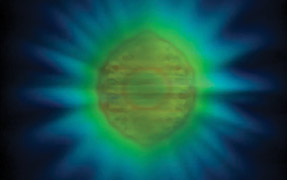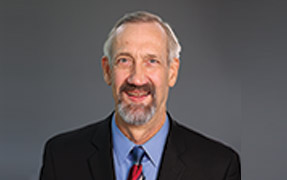#FacesofPhotonics: Aerospace Engineer Elaine Stewart

Meet Elaine Stewart: recent chemical engineering graduate, world-traveller, and aerospace engineer at NASA's Goddard Space Flight Center. Elaine is fascinated by space exploration and how optics affects our ability to "study distant stars that have never been seen before."
Her research has taken her around the world - from Bochum, Germany, where she studied material science and engineering at Rhur-Universität, to Houston, Texas, to work on the James Webb Space Telescope (JWST) while it was under cryogenic vacuum chamber testing, to Melbourne, Australia, where she studied biochemical and product engineering at the University of Melbourne in 2017. This past June, she graduated from the University of Delaware with a Bachelor's in Chemical Engineering.
Elaine makes a point of remaining an active member of the American Institute of Chemical Engineers (AIChE) Student Chapter, despite her busy schedule. She fulfills her duties as Social Chair by engaging the community in various outreach activities such as school visits, something she talks about in our interview.
Enjoy the Faces of Photonics interview with Elaine!

G'DAY, SKIPPY!: Stewart makes time to interact with the locals while studying at the University of Melbourne.
1. How did you become interested in the optics and photonics field? Was there a particular person who inspired you?
There are many engineers in my family, so I learned to appreciate science and see the amazing ways that engineering is integrated into our lives. I was encouraged by my early success in science and inspired by the excellent ideas of others. After my first internship with NASA at the Kennedy Space Center, I knew that I had found my dream job. In February 2016, I was selected to be a Pathways intern at Goddard Space Flight Center and was assigned to the James Webb Space Telescope (JWST) mission.
My NASA mentor, Dr. John C. Mather, Nobel Prize-winner and senior astrophysicist and project scientist, inspired me with his impressive career and his encouragement of young scientists through the John Mather Nobel Scholars Program. I have many positive influences in my life to encourage my interest in the field of optics and photonics-related research, especially my NASA colleagues. My goal is to inspire and promote this field to others.
2. Describe a memorable moment from an SPIE event or conference.
I have been fortunate to attend the SPIE Optics + Photonics conference in 2016 and 2018 in San Diego, CA. SPIE has been very generous in funding my optics and photonics research by awarding me the SPIE Education Scholarship and the Newport Research Excellence Grant.
In 2016, Ms. Nancy Carosso, a Goddard associate branch head and chief engineer, co-chaired SPIE O+P. She invited me to present my NASA research from the Kennedy Space Center on the Resource Prospector Mission which focused on in-situ resource utilization. I was involved in the integration and testing of the Regolith and Environment Sciences & Oxygen and Lunar Volatile Extraction (RESOLVE) payload.
In 2018 at SPIE Optics + Photonics, I presented my work on JWST, specifically the cryogenic vacuum chamber testing conducted at Johnson Space Center in Houston, Texas. At both conferences, I was able to connect with many scientists in the optics and photonics fields to share ideas and experiences. These conferences were invaluable to my personal and career development.

SPIE PRIDE: Showing off her Education Scholarship certificate at the 2018 SPIE Optics + Photonics conference.
3. Share the story of your favorite outreach or volunteer experience.
In spring 2017, I participated in an outreach event with Dr. Mather at the Newark Charter School in Delaware. We spoke to the students about the exciting science behind the JWST, as well as about STEM opportunities and internships at NASA. The students were very engaged and inspired at the possibility of a future career in science. I was honored to share my path from a young child fascinated by space to where I am today, working at NASA.
4. Explain your current research/what you do at your job. How does your work impact society?
Although I am early in my career, I am already contributing to the overall pursuit of aerospace and defense technologies. I am part of the NASA Goddard Space Flight Center engineering team working on the premier space science observatory, the JWST. It is an incredible experience to contribute to the mission success of JWST which will one day orbit the sun, 1.5 million kilometers from earth, seeking light that has traveled for 13.5 billion years from the first stars and galaxies formed after the Big Bang. In February 2016 I started as a NASA Engineering Pathways Intern in the Contamination and Thermal Coatings group and, upon my graduation, I was hired for a full-time position as an Aerospace Engineer.
For my chemical engineering senior project at the University of Delaware, I investigated and optimized shear-thickening fluids for spacesuit-fabric applications. This project was under the direction of Dr. Norman Wagner. Lower earth orbit provides challenges for astronauts to conduct extra-vehicular activities due to risks such as micrometeoroid and orbital debris damage. Shear thickening fluids (STF) are non-Newtonian fluids, exhibiting an increase in viscosity as applied shear rate increases. This nonlinear rheological behavior enhances fabric protection and performance by resisting penetration. My specific role in the project was to examine the material properties of formulations through torsional and puncture testing, rheology, and dynamic light scattering, in order to identify an optimal STF formulation for future use in space suit garments.
I also conducted research on ultracool brown dwarfs under the direction of Dr. John Gizis, a renowned astronomer, who discovered the star that hosts TRAPPIST-1 planets. My specific role was to investigate mid-infrared spectroscopy and photometry of ultracool brown dwarfs through the JWST Early Release Science Program to inform the interpretation of exoplanet spectra and knowledge of galaxy evolution.

HAPPIEST SPACE-PLACE ON EARTH: Stewart visits the Johnson Space Center and the JWST in Houston, Texas.
5. What is your advice to others in the STEM community?
Technology connects people globally, so there are limitless opportunities to apply your interests and fulfill your goals. Becoming knowledgeable in business and entrepreneurship is important to be a vital member of multi-functional teams. You should always think broadly and take advantage of new opportunities that are out of your comfort zone. When I first chose to study chemical engineering, I did not imagine that I would work on space exploration and optics projects like the NASA James Webb Space Telescope!
I am truly honored and grateful to be an SPIE Face of Photonics to encourage others to pursue their talents in STEM disciplines. Thank you.
| Enjoy this article? Get similar news in your inbox |
|



